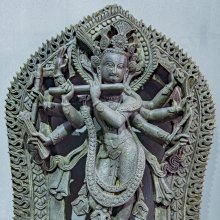Vaijayanti-mala, Vaijayantimala, Vaijayantīmālā: 1 definition
Introduction:
Vaijayanti-mala means something in Hinduism, Sanskrit. If you want to know the exact meaning, history, etymology or English translation of this term then check out the descriptions on this page. Add your comment or reference to a book if you want to contribute to this summary article.
Images (photo gallery)
In Hinduism
Pancaratra (worship of Nārāyaṇa)
Source: SriMatham: Vaiṣṇava Iconology based on Pañcarātra ĀgamaVaijayanti-mala (वैजयन्ति-मल):—The garland made of five types of forest flowers (or five jewels) is called the vaijyanti-mala the garland-of-victory. It symbolizes the five spheres of the senses, the display of manifestation which surrounds the Supreme Being.
pañca-rūpā tu yā mālā vaijayantī gadābhṛtaḥ |
sā bhūta hetu saṃghāto bhūtamālā ca vaidvija ||The necklace of the lord called Vaijayanti comprised of five precious gems, (pearl, ruby, emerald, sapphire and diamond) is the aggregate of the five elemental spheres. (V.P. 1;22;72.)

Pancaratra (पाञ्चरात्र, pāñcarātra) represents a tradition of Hinduism where Narayana is revered and worshipped. Closeley related to Vaishnavism, the Pancaratra literature includes various Agamas and tantras incorporating many Vaishnava philosophies.
Vaishnavism (Vaishava dharma)
Source: Pure Bhakti: Bhajana-rahasya - 2nd EditionVaijayantīmālā (वैजयन्तीमाला) refers to:—A garland made of five varieties of flowers and which reaches the knees. (cf. Glossary page from Bhajana-Rahasya).
Source: Pure Bhakti: Brhad BhagavatamrtamVaijayantīmālā (वैजयन्तीमाला) refers to:—A garland made of five different-colored flowers worn by Śrī Kṛṣṇa. (cf. Glossary page from Śrī Bṛhad-bhāgavatāmṛta).

Vaishnava (वैष्णव, vaiṣṇava) or vaishnavism (vaiṣṇavism) represents a tradition of Hinduism worshipping Vishnu as the supreme Lord. Similar to the Shaktism and Shaivism traditions, Vaishnavism also developed as an individual movement, famous for its exposition of the dashavatara (‘ten avatars of Vishnu’).
See also (Relevant definitions)
Partial matches: Vaijayanti, Maala, Mala.
Full-text: Vaijayantimala.
Relevant text
Search found 5 books and stories containing Vaijayanti-mala, Vaijayantimala, Vaijayantīmālā, Vaijayantī-mālā; (plurals include: malas, Vaijayantimalas, Vaijayantīmālās, mālās). You can also click to the full overview containing English textual excerpts. Below are direct links for the most relevant articles:
Brihad Bhagavatamrita (commentary) (by Śrī Śrīmad Bhaktivedānta Nārāyana Gosvāmī Mahārāja)
Chaitanya Bhagavata (by Bhumipati Dāsa)
Verse 2.6.78 < [Chapter 6 - The Lord’s Meeting with Advaita Ācārya]
Verse 1.5.127-134 < [Chapter 5 - Eating the Mendicant Brāhmaṇa’s Offerings]
Bhajana-Rahasya (by Srila Bhaktivinoda Thakura Mahasaya)
Text 16 < [Chapter 6 - Ṣaṣṭha-yāma-sādhana (Sāyaṃ-kālīya-bhajana–bhāva)]
Srila Gurudeva (The Supreme Treasure) (by Swami Bhaktivedanta Madhava Maharaja)
Puranic encyclopaedia (by Vettam Mani)
